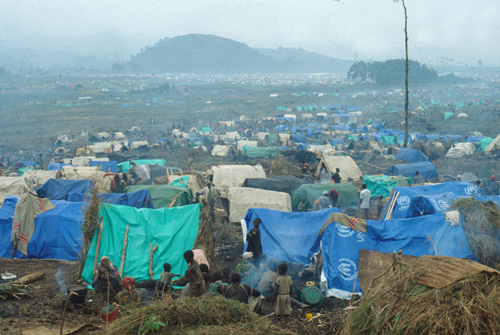Forcibly displaced persons now total more than 70.8 million; many at increased risk for vector-borne diseases: malaria throughout much of Africa, leishmaniasis in Syria, dengue in Yemen. The RBM VCWG hosts an initiative to facilitate innovative but practical steps to address vector control in these populations of such great need.
Forcibly displaced persons now total more than 70.8 million1; many are at increased risk for vector-borne diseases: malaria throughout much of Africa, leishmaniasis in Syria, Turkey and Iraq, dengue in Yemen and Bangladesh, among others. While some are in camps or settlements where standard tools can be deployed, many others are mobile, in makeshift shelters and situations where these are not practical. There is a gap where new tools in development can play a life-saving role, preventing disease proliferation and further health and economic impacts.
Much of the high-burden malaria population in Africa are in these complex operating environments.
We will not reach global malaria targets unless we address these ever-expanding challenges. There is urgent need to strengthen collaborations among industry, approval and procurement agencies and implementing partners to expand use of existing vector surveillance and control tools and facilitate the development of new tools and processes for communities burdened by vector-borne diseases beyond the reach of current strategies. Vector control in the aftermath of an emergency or disaster is NOT traditional vector control. It must not circumscribe interventions framed by "traditional" malaria or dengue vector control but address the broad spectrum of pests and vectors caused by crowding, inadequate housing and sanitation, environmental challenges and often a disruption of community systems.
The RBM Partnership to End Malaria hosts this partner initiative to address the growing need of vector control in humanitarian emergencies, advocating and building coordination among NGOs2 industry and manufacturers of key vector control tools adaptable for humanitarian emergency situations3, and international agencies, including from the WASH and shelter sectors4. These consultations resulted in recommended action points:
Improve use of existing vector and surveillance tools
- Acknowledge the challenge of “silos” in the sectors or cluster systems5 and address the need for a comprehensive approach to vector and pest control, especially among Health, WASH and Shelter.
- Establish a platform to provide basic technical capacity and exchange best-practices for vector control needs across all implementing agencies, sectors/clusters and host governments.
- Strengthen network for improved implementation of vector-borne disease control training and mentoring, planning, implementation, and assessments among partners and across the sectors/clusters especially, Health, WASH, Shelter, Education and Non-Food Items.
- Reassess and adapt specifications of standardized WASH, Shelter and Non-Food Item materials to reduce potential of vector proliferation and disease transmission, e.g. mosquito-proofing water containers, treated shelters and other treated materials.
- Ensure that camp design/management does not exacerbate vectors/pests through poor water management for mosquitoes (brick pits, water taps, containers), rodent, sand fly, and filth flies.
- Increase allocation to the Global Fund Emergency Fund6 and a Catalytic Fund7 for vector-borne diseases in emergencies; conduct a market and gap analysis of products and create a funded, pooled procurement mechanism with forecasted needs and pre-positioning of products to facilitate rapid deployment of appropriate vector control tools.
Facilitate the development, approval and deployment of new vector control tools
Current WHO-approved products for indoor residual spray, insecticidal nets and larval control are necessary but not sufficient, especially during the acute emergency phase.
- Engage partners in industry, policy, implementation and product development consortia in development of products addressing the particular needs of humanitarian emergencies, and outdoor vector-borne pathogen transmission more generally.
- Recognize there are products already approved by Stringent Regulatory Authorities to kill or repel vectors and are safe to humans and the environment, that can be deployed, adapted and improved by emergency relief organizations.
- Do not let the perfect be the enemy of the good. Adapt the WHO-approval process to enable deployment of toxicologically safe and entomologically effective products using evaluation methods that do not rely on randomized control trials with epidemiological endpoints, requirements that are not practical in emergency settings.
Conclusion
High burden vector-borne disease settings are often characterised by poor security, limited governance, destroyed essential services and infrastructure, mass population displacement, malnutrition, and often overlaid with natural disasters. The conditions these environments create not only exacerbate vector-borne and other disease transmission, but also dramatically increase people’s vulnerability to infection, complicate its prevention, diagnosis and treatment, while increasing morbidity and mortality rates.
There are innovative but practical policy, coordination and implementation steps we as a community can make to address the vector control challenges of these ever-increasing populations with such great needs. We can prevent disease, save lives, and make more efficient used of limited resources.
The mechanisms and many of the tools are available now. We must act.
Contact:
Vector Control in Humanitarian Emergencies VCHE@endmalaria.org
1 https://www.unhcr.org/figures-at-a-glance.html
2 https://endmalaria.org/sites/default/files/Vector-Control-Humanitarian-Emergency-meeting-report-.pdf
4 Meeting 5 Feb UNHCR/Geneva. Report pending, will be posted on https://endmalaria.org/our-work-working-groups/vector-control
